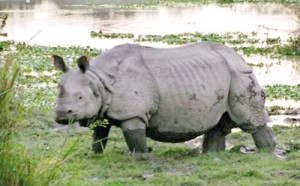Kaziranga: Roaming in Rhino land
 One of India’s most popular national parks, the Kaziranga National Park is 430 square kilometres. It is well known for its Rhinoceros (Rhinoceros unicornis), Elephants (Elepha smaximus), Tigers (Panthera tigris) and a variety of birds including many migrants. Kaziranga is also a World Heritage site.
One of India’s most popular national parks, the Kaziranga National Park is 430 square kilometres. It is well known for its Rhinoceros (Rhinoceros unicornis), Elephants (Elepha smaximus), Tigers (Panthera tigris) and a variety of birds including many migrants. Kaziranga is also a World Heritage site.
Whilst at Kaziranga I had the rare pleasure of meeting the great Indian naturalist Valmik Thapar who was staying at the same lodge, called Wild Grass, that we were staying in. Thapar is well known for his efforts to conserve endangered Indian wildlife, especially tigers. His films, videos etc on tigers are world renowned. Talking to him was a wide ranging education in wildlife conservation.
This park is basically in two parts, separated by the Guwahati – Kaziranga main highway. The eastern part is low lying land through which the Brahmaputra, which is India’s biggest river, makes its way down towards the sea, dividing the low land part of Kaziranga into two parts.
This river which starts inTibet, where it is known as Tsangbo is the longest river of Tibet. From Tibet it flows into the state of Arunachal Pradesh, in India. Downstream from Arunachal Pradesh the river becomes phenomenally wider and is called the Siang. After reaching Assam, the river is known as Brahmaputra.
On the other side of the highway is a large area of jungle which is on a steep hill.
Every year with the rains the Brahmaputra overflows its banks and completely floods the low-lying side of Kaziranga at high levels of flood. When the waters rise, different species of animals, led by the elephants, go away quickly from the flooded area onto the hills which are covered in jungle. Most of these animals use the five broad highway crossings that the park authorities have created. Motorists are warned of the animals crossing and are cautioned to drive slowly.
The last census, carried out in 2015, has shown that the park hosts 2401 Rhinos. The flood in 2016 has been the worst in the decade. During this period 22 Rhinos drowned. Nine babies who could not swim and 13 adults. Since Rhinos are usually strong swimmers these adults would have been either old or sick.
Rhinos defecate on the same spot for 15 -20 days or so and move onto another spot. Since they only use open areas to defecate, piles of dung, in various stages of decomposition, can be seen along the roads that run through the park.

The writer (second from left) with Indian naturalist Valmik Thapar (left)
Kaziranga also has the world’s highest ecological density of the tiger in any national park in the world. The number of tigers in India has reduced drastically in the last two decades but has now increased somewhat. This park also has the world’s largest population of the Asiatic Wild Buffalo (Bubal-usbubalis).
Some of the birds seen were: Bar-headed Geese, Greylag Geese (these geese breed in Ladak up in the north and come down in winter to feed), Ruddy Sheldrake, Mallard, Common Teal, Eastern Spoonbill, Widgeon, Gadwal, Black-necked Stork, Dusky Spotted Owl on a Fishing Eagles nest, Phallas Eagle, Fishing Eagle, Serpent Eagle, Tawny Eagle, Changeable Hawk Eagle, Kaleej Pheasant, Indian Jungle Fowl (both the Indian female and male are different from the Sri Lankan Jungle Fowl) and large, intermediate (or Medium), Small and Cattle Egrets.
The Drongo is known locally as Policeman since it drives off the birds of prey allowing the smaller birds to forage in peace.
There were plenty of Barking Deer, Swamp Deer and Hog Deer to be seen.


